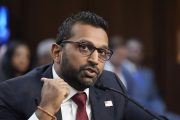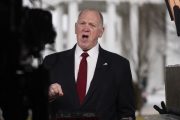
President Trump ordered the release on October 26 of more than 2,800 of the previously withheld documents related to the investigation into the assassination of former President John F. Kennedy, but bowed to pressure from the CIA and FBI by withholding approximately 300 additional records, pending six more months of review.
October 26 was the federal government’s deadline to release the 3,100 previously unavailable files, a deadline that was set by Congress in 1992 under the President John F. Kennedy Assassination Records Collection Act. The documents have been held in the National Archives, and the majority are already available for public viewing.
The records that were released are available on the National Archive’s website.
The New York Times reported that Trump had “expressed eagerness to finally open the last of the government files, only to run into a last-minute campaign by intelligence agencies to redact certain documents. Grudgingly, he gave the agencies until April 26 to go through the remaining papers again and make their case.”
There is no way for us to ascertain how grudgingly (or willingly) the president acceded to the agencies’ pressure to withhold some documents. Or, for that matter, whether these agencies might use their sophisticated technological expertise not merely to redact, but to erase, any trace of information that they do not want to be made public.
“I am ordering today that the veil finally be lifted,” Trump said in a memo to the agencies. Given their objections, he said, “I have no choice — today — but to accept those redactions rather than allow potentially irreversible harm to our nation’s security.” But he ordered the agencies to “be extremely circumspect,” noting that the rationale for secrecy has only “grown weaker with the passage of time.”
White House press secretary Sarah Huckabee Sanders said in a statement posted on the White House website on October 26:
Today, President Donald J. Trump took action to ensure release of the remaining President John F. Kennedy Assassination Records. Accordingly, the National Archives and Records Administration will make approximately 2,800 records available in full for public access today. The remaining records will be released with agency-proposed redactions on a rolling basis in the coming weeks. The President has demanded unprecedented transparency from the agencies and directed them to minimize redactions without delay. The National Archives will therefore release more records, with redactions only in the rarest of circumstances, by the deadline of April 26, 2018.
Administration officials said the intelligence agencies’ demands to delay the complete release does not amount to a coverup, just an effort to avoid compromising national security, law enforcement, or intelligence gathering methods, observed the Times. While it is not unusual for these agencies to classify records to protect ongoing operations and the names of undercover operatives, it is difficult to believe that any of this information would still be relevant 54 years after the fact. Any operations being conducted back in 1963 have surely long ended, and any operatives working in secret back then would have either retired or died.
Many journalists have expressed the opinion that it was Oliver Stone’s 1991 film JFK, which explored several theories about the assassination that were contrary to the “official” government version, that generated the public pressure to learn the complete truth and prompted Congress to pass, and President George H.W. Bush to sign, the “President John F. Kennedy Assassination Records Collection Act of 1992.” The law required the government to release all its files on the assassination in 25 years.
Prior to the passage of that law, most of the official information about the assassination was found in a report from the President’s Commission on the Assassination of President John F. Kennedy. Since the commission was chaired by Chief Justice Earl Warren, its findings — published in 1964 in a 469-page report, accompanied by 410 pages of appendices — were called the Warren Commission Report.
Two months later, approximately a full year after its beginning, the Commission brought forth 26 volumes of supporting documents, including the testimony or depositions of 552 witnesses along with 3,100 exhibits.
An article written by Jack Kenny about the widespread skepticism about the reliability of the Warren Commission Report, which has existed almost from the time of its release, was posted by The New American for the 50th anniversary of the assassination in 2013. The article cited Warren Commission critic Sylvia Meagher, who in her 1966 book, Accessories After the Fact, noted that Dallas officials seemed to believe they had solved the president’s assassination and the murder of police officer J.D. Tippitt in very little time and that Oswald’s body was hardly cold before a police spokesman announced the case was closed. Kenny observed that the conclusions published by the Warren Commission 10 months later were virtually identical to the verdict announced in Dallas a mere 48 hours after President Kennedy was shot. That is: “Lee Harvey Oswald was the lone assassin, who also killed Tippitt. Jack Ruby acted solely on his own in killing Oswald. No sign of conspiracy anywhere.”
As Kenny noted in his article (and as countless others who have studied the events surrounding the assassination have also concluded), there are too many disturbing contradictions to the “lone assassin” view presented by the Warren Commission to not only doubt its findings, but to demand that all of the evidence be made public. These contradictions include:
• Multiple witnesses claimed to have seen one or more persons at the same sixth floor window of the Texas Schoolbook Depository building moments before Oswald allegedly fired the fatal shots at Kennedy, but only one man, Howard Brennan, claimed to have seen Oswald there.
• The rifle found on the sixth floor was initially identified by Deputy Constable Seymour Weitzman as a German Mauser, but later turned out to be an Italian-made Mannilicher-Carcano mailed to “A.J. Hiddel,” which police said was an alias used by Oswald.
• Perhaps the most well-publicized statements suggesting that another gunman (or gunmen) besides Oswald was involved came from many of the people in Dealey Plaza that day who believed the shots came from behind the stockade fence atop the “grassy knoll” that was to the front and right of the president.
One of these witnesses, Gordon L. Arnold, a 22-year-old soldier in uniform at the time, recalled standing near the top of the knoll as the motorcade approached. Jim Marrs, author of Crossfire: The Plot That Killed Kennedy, interviewed Arnold in 1985 and quoted him as follows:
Just after the car turned onto Elm Street and started toward me, a shot went off from over my left shoulder. I felt the bullet rather than heard it, and it went right past my left ear…. You don’t really hear the whiz of a bullet; you feel it. You feel something go by and then you hear a report just behind it.
We cannot know if the information released to the public on October 26 (only a small amount of which has been thoroughly examined by journalists at the time we are writing) will provide the “smoking gun” that those who doubt the findings of the Warren Commission Report are hoping for. If there were other assassins besides Oswald who participated in Kennedy’s killing, then there must have been some politically expedient reason for covering up that information. We cannot state unequivocally that that is the case, however, because our government has kept too much of the evidence hidden for 54 years.
This, of course, raises an important point: Innocent people who have nothing to hide do not engage in a concerted effort to bury the truth. Why has it taken all these years to release even some of the files?
Much of the speculation may be resolved when our government releases all of the JFK files between now and April 26. But, then again, it might not. Can anyone doubt that if powerful individuals within our intelligence community had wanted to hide information contradicting the Warren Commission Report, they would have long ago had such records destroyed?
Photo: wikipedia
Related articles:
History Still Casts Doubts on the Warren Commission Report
JFK Assassination and Boston Marathon Bombing: A Tale of Two Manhunts




